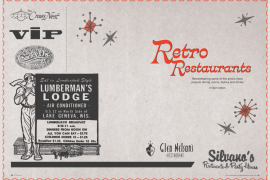By Lisa Schmelz
Editor’s Note: Late last year, the Delavan Theater was purchased by local businessman Jim Beall, who plans to create a venue for live entertainment.
A shared experience in a darkened room, with all eyes focused on the same big screen, is rare today. But once upon a time, it wasn’t. Struggling to recall this bygone time?
Visit the historic Sprague Theatre in downtown Elkhorn and prop the door open. That’s what Warren Radtke, a member of the Lakeland Players, and Linda Kouzes, the group’s cofounder, did on a recent sun-kissed day. Their aim was to circulate some air in the acting troupe’s now permanent home, and passersby couldn’t keep from wandering in.
“Hello,” called Kim Dugan of Elkhorn, downtown for a lunch date at the Elk Restaurant. “Can I come in? I just want to look around. It’s been years since I was here.”
Radtke and Kouzes, seated in the lobby, nodded and smiled. Dugan reverently walked past and into the 240-seat theater. She returned awash in nostalgia.
“Every Friday night, I came to a movie here,” she says softly, as though in a church. “We used to see movies here, musicals sometimes, and the next morning, my sister and I would sing all the songs. It was in the ‘60s and ‘70s. I’m pretty old, but I remember it so clearly.”
Dugan is not alone. Our memories of motion pictures we viewed in old theaters like this are powerful. Locally, there was no shortage of places to take in a movie from the late 1920s through the 1980s. East Troy, Elkhorn, Delavan, Lake Geneva and Walworth all had their own movie houses, many with their roots as opera houses or vaudeville stages. Delavan even had a drive-in on the east side of town.
As time marched on, however, it took with it most historic movie theaters. Now, just three in the lakes area remain standing, and only one, the Geneva Theater, still shows motion pictures. So, join us as we raise the curtain on the history of local theaters. We can’t serve you popcorn, and this is by no means the complete story, but we hope you’ll enjoy these reels of the past.
THE GENEVA THEATER
Movie stars often say they were in the right place at the right time when they were discovered and went on to make it big. The same could be said for the Geneva Theater and its longevity as a cinema. The only historic movie house in Walworth county still showing movies, its location, boosted by year-round tourism, proves ideal. Opened in 1928, it is owned today by Shad Branen, who also owns the Plaza Theater in nearby Burlington.
When he purchased the long-neglected Geneva in 2016, Branen had his work cut out for him. The roof was leaking. The seats were prone to dropping to the floor. The grand vaudeville stage, which once hosted acts from around the country, needed shoring up. Still, Branen saw a happy ending in an era when many get their movie-fixes online.
“We’re having a banner year,” he says in his lobby. “It’s a record year in the industry.”
Why is that? “The same reason that people want to go out to eat, it’s about going and being among people. It’s an experience. Millennials and young families, they want an experience. You can’t beat the experience of sitting down in our theater one, in our 1928 theater, and seeing a movie on that big screen.”
Branen and his marketing coordinator, Marie Frederick, say being a hometown movie theater still serves this four-screen theater well. People crave not only an experience, the duo says, but want to plug into the community.
To that end, they sometimes host movie tie-in scavenger hunts. When the Lego movie came out, they had a Lego-build. Trivia games before a movie aren’t uncommon here, nor are nationally touring comedians seen on major cable networks. “We want to involve the community. We want to bring people up on stage and introduce them,” says Branen. “That’s what it means to be a hometown theater.”
Later this year, the theatre will be home to a 1927 pipe organ. Once a music bed for silent films, the organ is being restored and installed by the nonprofit Dairyland Theater Organ Society. “It will be such a wonderful addition when it’s here and installed,” says Frederick. “It gives them a venue to play concerts and us a connection to what was once here.”
THE SPRAGUE
When the Sprague Opera House in Elkhorn burned down in 1925, businessman Dan Kelliher saw an opportunity and commissioned a 400-seat theater with architect Alex Baur and designer John Yonk. Kelliher invited Edward Sprague to speak at the May 31, 1928, grand opening of the theater bearing his name. Less than a year later, Kelliher invested $6,000 in new “talking picture equipment.” On May 7, 1929, Elkhorn hosted its first talking picture, “Broadway Melody.”
Linda Kouzes, 82, wasn’t around then, but she did start teaching physical education at the high school in Elkhorn in 1958 and recalled The Sprague was always more than a movie house. “He [Kelliher] always opened the theater for Halloween for free for the kids,” she says. “He was a real giver.”
Today, the Sprague Theatre is home to the Lakeland Players. The projection booth is still accessible by a steep set of stairs, but now the show is live theater. Actors for the four shows annually are tapped through open-to-all auditions.
What does Kouzes, a movie usher in her teens, miss most about the movies once shown here? “Movies used to be happier,” she says. “I used to go once a week. “You felt better when you left. You were happy. And the other thing nowadays is the price. They charge more for refreshments than they do for the movie.”
THE DELAVAN THEATER
How’d you like to own your very own old-time movie theater? Well, look no further than downtown Delavan. For just $349,900, you can own a piece of cinema history.
Opened on May 15, 1929, by four local businessmen, it was dubbed a Temple of Happiness by the local paper. “The Glad Rag Doll,” starring Dolores Costello, was the premier, talking picture. The local paper went on to report that the film was “so new” that there were fears it wouldn’t be available for opening night. But “final arrangements were made with New York” and the print was “delivered at Delavan” on the afternoon of opening night.
The theater appears to have ceased showing movies to the public in 1999. In 2006, it became the home of The River Church after members of the congregation, who had been meeting in a local school, decided to investigate the empty theater for their use. Five couples in the congregation purchased the Delavan Theater and the church moved in, leasing the space from the owners. The congregation recently moved to Community Park on Delavan Lake.
That means this 9,000+-square-foot, 239-seat theater, with original dressing rooms, fly system for scene backdrops and orchestra pit, needs a third act. Joan Kost is one of the 10 owners.
“I’d love to see it show movies again or performances,” she says. “The projection room is still up there, there’s a stage. It would be such a wonderful asset to the community.”
THE LAKES OUTDOOR THEATER
This classic drive-in, located between Delavan and Williams Bay, opened in 1954 and hosted up to 800 cars and countless movie fans a night in the spring and summer. Just don’t go looking for photos of this place or an exact closing date. We searched high and low for this story and came up with just a handful of poor-quality images from old newspapers and no specific last film date. Movies were shown here through at least the 1970s, and some residents think possibly the early ’80s. Like drive-ins around the country, The Lakes Outdoor Theater fell victim to the modernization of indoor theaters.
Though the paper trail on The Lakes, as locals called it, is scant, the best archival material we found comes from former Chicago Tribune film critic Michael Wilmington. His ode to the drive-in theater of his youth was titled “Empty Field of Dreams.” Published May 10, 1998, in the Chicago Tribune, Wilmington offered these words as a eulogy:
“The other day, I heard from an old friend that last remnants of The Lakes Outdoor Theater, where I saw hundreds of movies in my youth, had been torn down and the whole area turned into a compost plant… I felt a twinge. Somehow, I still see it there: that huge unmarred white square rising out of the fields and farmland all around it, shining in the night with its gigantic images of John Wayne and Jimmy Stewart in cowboy outfits or Cary Grant ogling Marilyn Monroe, visible for miles around in every direction, just as it was when I was 12.”
Yes, the once popular drive-in on Theater Road is the stuff of movie legends. If you spent any time at The Lakes, taking in its double features, and want to relive that, go online and search for Wilmington’s column. Or talk with a local like Ron Deschner. A retired builder, and current member of the Delavan-Darien School Board, he remembers it like it was yesterday.
The first time he was there, he thinks he was 7- or 8-years-old. His folks popped their own corn, he says, and loaded the family up in their ‘37 Chevrolet. As a teen, he drove himself.
“We used to put a couple of people in the trunk,” he says. “We would pay for two and get four in. It was usually half to three-fourths full out there. You’d pull up to your spot, and it was ramped, just gravel, but ramped so you had a better view, and you got your speaker onto your window. We loved sitting out there. It was wonderful. Sometimes, we even sat there in the rain. We didn’t care. It was terrific.”
THE WALWORTH THEATER & SHOWETTE
Nancy Lehman is the president of the Historical Society of Walworth and Big Foot Prairie. Her memory of the past is razor-sharp and objective. Recalling The Walworth Theatre & Showette, however, her recollections tilt heavily toward wistful. The movie house in this village, she explains, was on the southern end of the village square, next to Walls Department Store. Today, it is a vacant lot.
“We went usually on Saturday night, sometimes Friday,” she recalls. “That was the big thing. And then we’d have popcorn.”
Does she have a favorite movie? “Oh, I don’t know. I saw them all,” she says. “It was the best theater in the area. Very modern.”
As theaters went, this one came later to the game in Walworth County. Opened on April 25, 1947, its seats “pushed back,” offering a more comfortable viewing experience. Built by Constantine Papas of New York, the theater was managed by Thomas Finn from 1948 to 1974. The Showette side, next to the lobby, was open for refreshments to moviegoers and those just hankering for something to eat.
Like many historic theaters, The Walworth Theater & Showette fell victim to new ways people could view motion pictures in their own homes. Operated successfully until about 1979, according to archives at the Historical Society of Walworth and Big Foot Prairie, the theatre gradually fell into disrepair. Following a roof collapse, it was razed.
“It was such a great thing to have in our community, and it was beautiful,” says Lehman. “We were lucky to have it as long as we did.”





